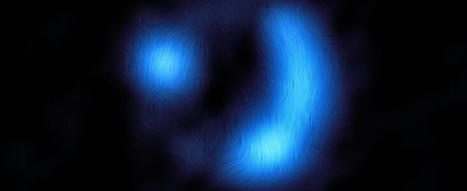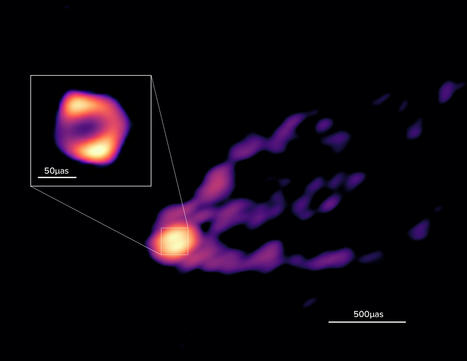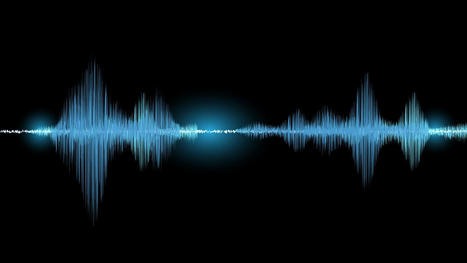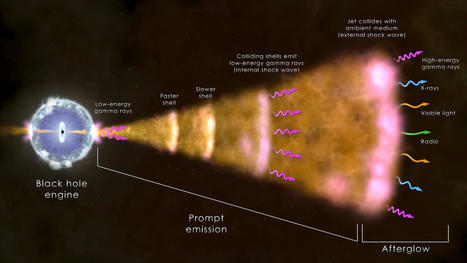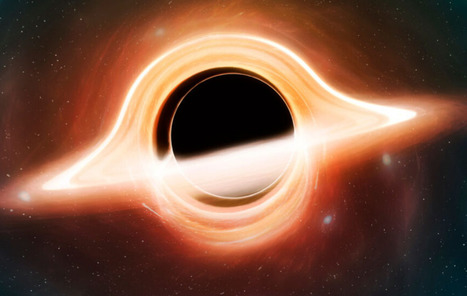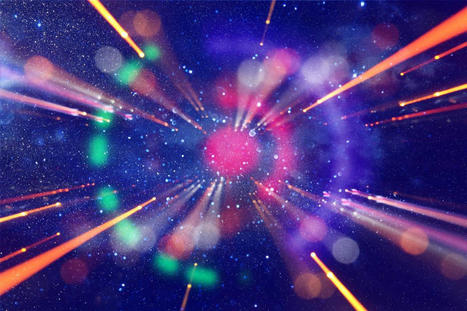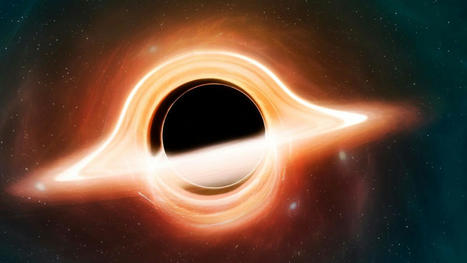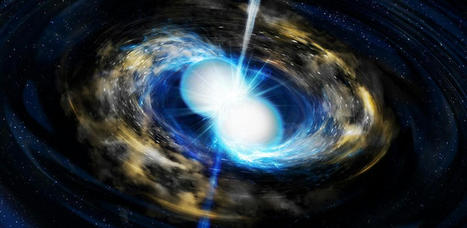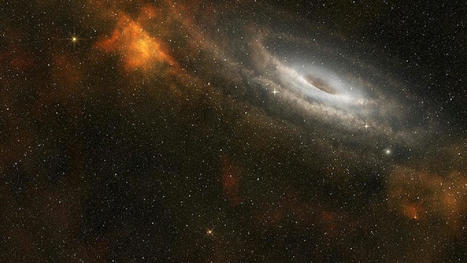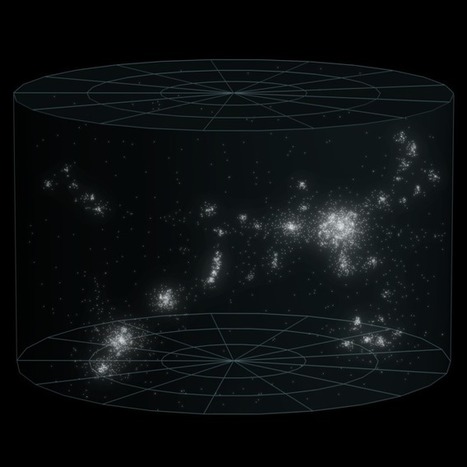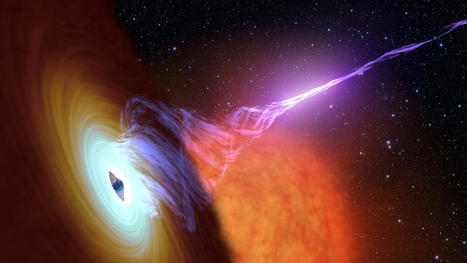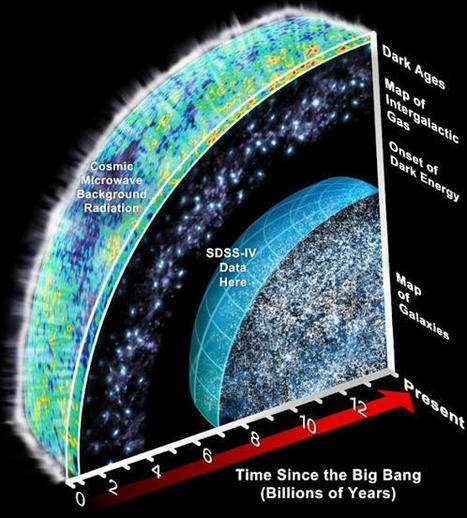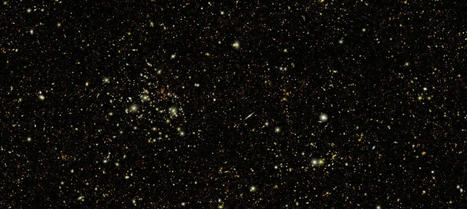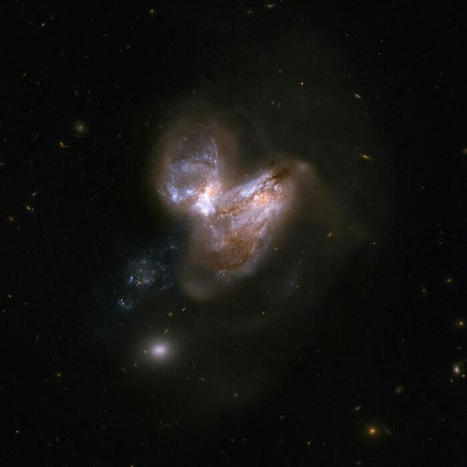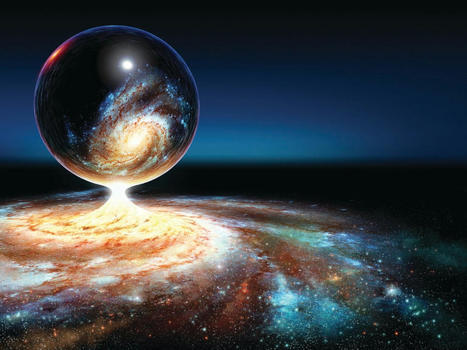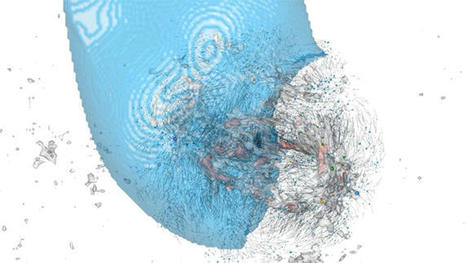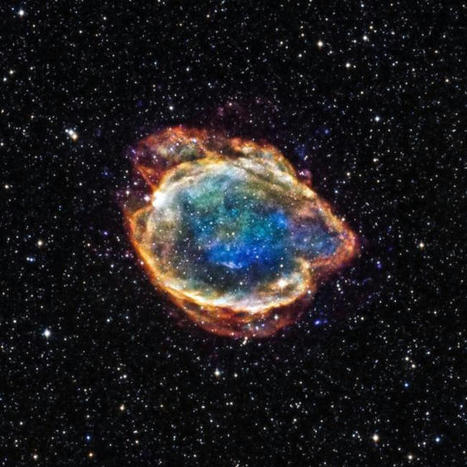 Your new post is loading...
Using the Atacama Large Millimeter/submillimeter Array (ALMA), astronomers have detected the magnetic field of a galaxy so far away that its light has taken more than 11 billion years to reach us: we see it as it was when the Universe was just 2.5 billion years old. The result provides astronomers with vital clues about how the magnetic fields of galaxies like our own Milky Way came to be. Lots of astronomical bodies in the Universe have magnetic fields, whether it be planets, stars or galaxies. “Many people might not be aware that our entire galaxy and other galaxies are laced with magnetic fields, spanning tens of thousands of light-years,” says James Geach, a professor of astrophysics at the University of Hertfordshire, UK, and lead author of the study published today in Nature. “We actually know very little about how these fields form, despite their being quite fundamental to how galaxies evolve,” adds Enrique Lopez Rodriguez, a researcher at Stanford University, USA, who also participated in the study. It is not clear how early in the lifetime of the Universe, and how quickly, magnetic fields in galaxies form because so far astronomers have only mapped magnetic fields in galaxies close to us. Now, using ALMA, in which the European Southern Observatory (ESO) is a partner, Geach and his team have discovered a fully formed magnetic field in a distant galaxy, similar in structure to what is observed in nearby galaxies. The field is about 1000 times weaker than the Earth’s magnetic field, but extends over more than 16 000 light-years. “This discovery gives us new clues as to how galactic-scale magnetic fields are formed,” explains Geach. Observing a fully developed magnetic field this early in the history of the Universe indicates that magnetic fields spanning entire galaxies can form rapidly while young galaxies are still growing.
Scientists studying the supermassive black hole at the heart of the M87 galaxy have revealed the origins of the monster's powerful jet and imaged the jet and its source together for the first time. What's more, the observations have revealed that the black hole's ring is much larger than scientists previously believed. The observations were published (April 26, 2023) in the prestigious science magazine Nature. The Global mm-VLBI Array (GMVA) united radio telescopes around the world to produce these new results, including the National Science Foundation's National Radio Astronomy Observatory (NRAO) and Green Bank Observatory (GBO), Atacama Large Millimeter/ submillimeter Array (ALMA), Very Long Baseline Array (VLBA), and Green Bank Telescope (GBT). The SMBH at the center of the M87 galaxy is the most recognizable in the universe. It was the first black hole to be captured in an image, created by the Event Horizon Telescope (EHT) and made public in 2019. The image of its dense, dark core framed by an amorphous glowing ring made international headlines. "M87 has been observed over many decades, and 100 years ago we knew the jet was there, but we couldn't place it in context," said Ru-Sen Lu, an astronomer at the Shanghai Astronomical Observatory, leader of a Max Planck Research Group at the Chinese Academy of Sciences, and lead author of the new paper. "With GMVA, including the premier instruments at NRAO and GBO, we're observing at a lower frequency so we're seeing more detail— and now we know there are more details to see." Eduardo Ros, an astronomer and the Scientific Coordinator for Very Long Baseline Interferometry (VLBI) at the Max Planck Institute for Radio Astronomy added, "We've seen the ring before, but now we see the jet. This puts the ring in context—and it's bigger than we thought. If you think of it like a fire-breathing monster, before, we could see the dragon and the fire, but now we can see the dragon breathing the fire."
Since its discovery in 2007, fast radio bursts (FRBs) have baffled astronomers. FRBs are powerful, millisecond-long radio bursts from space that produces as much energy during their brief existence as the Sun produces over a few days. Very little is known about what or how most FRBs are produced; most come from outside our Milky Way galaxy. However, one FRB that has never stopped repeating has been highlighted by a NEW study recently published in Science. Using the five-hundred-meter Aperture Spherical Radio Telescope (FAST) in China, astronomers identified the repeated burst in 2022 as FRB 20190520B. FRB 20190520B, which produces radio bursts a few times an hour, occasionally at different radio frequencies, is the rarest repeating FRB of all. Astronomers hurried to extend the original study using additional radio frequencies after discovering this exciting phenomenon. Powerful magnetic fields surrounding the burst Further research revealed that FRB 20190520B is located in a 3.9 billion light-year-distance dwarf galaxy, home to an incredibly dense environment. The FRB source is surrounded by substances that emit powerful, long-lasting radio waves. The exploding source was speculated to be a young neutron star in a complex environment as a result of this. The burst emits potent signals at relatively high radio frequencies, according to observations of FRB 20190520B made with the CSIRO Parkes radio telescope in New South Wales, the Green Bank Telescope in the United States, and the Murriyang radio telescope in Australia. The electromagnetic waves in these high-frequency transmissions turned out to be highly polarized, which means they are "waving" in one direction considerably more powerfully than in others. Different frequencies cause this polarization to shift in direction, and monitoring how much it varies lets us know how strong the magnetic field was when the signal passed through. This polarization measurement indicates a highly magnetized environment surrounding FRB 20190520B. Additionally, throughout the 16 months that astronomers monitored the source, the magnetic field's strength appeared to change and even reverse directions twice. The magnetic field's direction around an FRB has never been seen to alter. Binary System Hypothesis Recent observations of recurrent FRBs are most commonly explained by binary systems, consisting of a neutron star and another massive star or a black hole. The most recent findings support the concept involving a big star. However, other possibilities cannot yet be ruled out. Strong stellar winds and well-organized magnetic fields are known to surround massive stars. A reversal is anticipated in the direction of the magnetic field direction if the source of the bursts were going in and out of the stellar wind region as it moved through its orbit. This explanation is supported by the timing of the magnetic field reversal, the observed variability in the apparent field strength, and the concentrated plasma surrounding the burst source.
Thanks to data from a magnified, multiply imaged supernova, a team led by University of Minnesota Twin Cities researchers has successfully used a first-of-its-kind technique to measure the expansion rate of the Universe. Their data provide insight into a longstanding debate in the field and could help scientists more accurately determine the Universe's age and better understand the cosmos. The work is divided into two papers, respectively published in Science, one of the world's top peer-reviewed academic journals, and The Astrophysical Journal, a peer-reviewed scientific journal of astrophysics and astronomy. In astronomy, there are two precise measurements of the expansion of the Universe, also called the "Hubble constant." One is calculated from nearby observations of supernovae, and the second uses the "cosmic microwave background," or radiation that began to stream freely through the Universe shortly after the Big Bang. However, these two measurements differ by about 10 percent, which has caused widespread debate among physicists and astronomers. If both measurements are accurate, that means scientists' current theory about the make-up of the universe is incomplete. "If new, independent measurements confirm this disagreement between the two measurements of the Hubble constant, it would become a chink in the armor of our understanding of the cosmos," said Patrick Kelly, lead author of both papers and an assistant professor in the University of Minnesota School of Physics and Astronomy. "The big question is if there is a possible issue with one or both of the measurements. Our research addresses that by using an independent, completely different way to measure the expansion rate of the Universe." The University of Minnesota-led team was able to calculate this value using data from a supernova discovered by Kelly in 2014 -- the first ever example of a multiply imaged supernova, meaning that the telescope captured four different images of the same cosmic event. After the discovery, teams around the world predicted that the supernova would reappear at a new position in 2015, and the University of Minnesota team detected this additional image. These multiple images appeared because the supernova was gravitationally lensed by a galaxy cluster, a phenomenon in which mass from the cluster bends and magnifies light. By using the time delays between the appearances of the 2014 and 2015 images, the researchers were able to measure the Hubble Constant using a theory developed in 1964 by Norwegian astronomer Sjur Refsdal that had previously been impossible to put into practice. The researchers' findings don't absolutely settle the debate, Kelly said, but they do provide more insight into the problem and bring physicists closer to obtaining the most accurate measurement of the Universe's age. "Our measurement favors the value from the cosmic microwave background, although it is not in strong disagreement with the supernova value," Kelly said. "If observations of future supernovae that are also gravitationally lensed by clusters yield a similar result, then it would identify an issue with the current supernova value, or with our understanding of galaxy-cluster dark matter." Using the same data, the researchers found that some current models of galaxy-cluster dark matter were able to explain their observations of the supernovae. This allowed them to determine the most accurate models for the locations of dark matter in the galaxy cluster, a question that has long plagued astronomers. This research was funded primarily by NASA through the Space Telescope Science Institute and the National Science Foundation.
On October 9, 2022, an intense pulse of gamma-ray radiation swept through our solar system, overwhelming gamma-ray detectors on numerous orbiting satellites, and sending astronomers on a chase to study the event using the most powerful telescopes in the world. The new source, dubbed GRB 221009A for its discovery date, turned out to be the brightest gamma-ray burst (GRB) ever recorded. In a new study that appears today in Astrophysical Journal Letters, observations of GRB 221009A spanning from radio waves to gamma-rays, including critical millimeter-wave observations with the Center for Astrophysics | Harvard & Smithsonian's Submillimeter Array (SMA) in Hawaii, shed new light on the decades-long quest to understand the origin of these extreme cosmic explosions. This study is part of a series of discoveries that are to be published as a collection in Astrophysical Journal Letters. The gamma-ray emission from GRB 221009A lasted over 300 seconds. Astronomers think that such "long-duration" GRBs are the birth cry of a black hole, formed as the core of a massive and rapidly spinning star collapses under its own weight. The newborn black hole launches powerful jets of plasma at near the speed of light, which pierce through the collapsing star and shine in gamma-rays. With GRB 221009A being the brightest burst ever recorded, a real mystery lay in what would come after the initial burst of gamma-rays. "As the jets slam into gas surrounding the dying star, they produce a bright 'afterglow' of light across the entire spectrum," says Tanmoy Laskar, assistant professor of physics and astronomy at the University of Utah, and lead author of the study. "The afterglow fades quite rapidly, which means we have to be quick and nimble in capturing the light before it disappears, taking its secrets with it." As part of a campaign to use the world's best radio and millimeter telescopes to study the afterglow of GRB 221009A, astronomers Edo Berger and Yvette Cendes of the Center for Astrophysics (CfA) rapidly gathered data with the SMA. "This burst, being so bright, provided a unique opportunity to explore the detailed behavior and evolution of an afterglow with unprecedented detail—we did not want to miss it," says Edo Berger, professor of astronomy at Harvard University and the CfA. "I have been studying these events for more than twenty years, and this one was as exciting as the first GRB I ever observed."
Black holes exist in our universe. That’s widely accepted today. Physicists have detected the X-rays emitted when black holes feed, analyzed the gravitational waves from black hole collisions and even imaged two of these behemoths. But mathematician Elena Giorgi of Columbia University studies black holes in a different way. “Black holes are mathematical solutions to the Einstein equation,” Giorgi says — the “master equation” that is the basis of the general theory of relativity. She and other mathematicians seek to prove theorems about these solutions and otherwise probe the math of general relativity. Their goal: unlock unsuspected truths about black holes or verify existing suspicions. Within general relativity, “one can understand clean mathematical statements and study those statements, and they can give an unambiguous answer within that theory,” says Christoph Kehle, a mathematician at ETH Zurich’s Institute for Theoretical Studies. Mathematicians can solve equations that have bearing on questions about the nature of black holes’ formation, evolution and stability. Last year, in a paper posted online at arXiv.org, Giorgi and colleagues settled a long-standing mathematical question about black hole stability. A stable black hole, mathematically speaking, is one that if poked, nudged or otherwise disturbed will eventually settle back into being a black hole. Like a rubber band that has been stretched and then released, the black hole doesn’t rip apart, explode or cease to exist, but returns to something like its former self. Black holes seem to be physically stable — otherwise they couldn’t endure in the universe — but proving it mathematically is a different beast. And a necessary feat, Giorgi says. If black holes are stable, as researchers presume, then the math describing them had better reflect that stability. If not, something is wrong with the underlying theory. “Most of my work,” Giorgi says, “is about proving things that we already expected to be true.” Mathematics has a history of big contributions in the realm of black holes. In 1916, Karl Schwarzschild published a solution to Einstein’s equations for general relativity near a single spherical mass. The math showed a limit to how small a mass could be squeezed, an early sign of black holes. More recently, British mathematician Roger Penrose won the 2020 Nobel Prize in physics for his calculations showing that black holes were real-world predictions of general relativity. In a landmark paper published in 1965, Penrose described how matter could collapse to form a black hole with a singularity at its center.
Galaxies come in many different shapes and sizes, but the basic ingredients seem fairly consistent. There's usually a big black hole at the center, a bunch of stars and gas, and a generous serving of dark matter that helps glue the whole thing together. While dark matter is, well, dark, the stars, gas, and swirling core of heated material stand out with the radiant beauty of a city in the night. However, one newly discovered dwarf galaxy located a mere 94 million light-years away is defying expectations. It's named FAST J0139+4328, and it's not emitting any optical light. In fact, it's barely emitting any light at all. FAST J0139+4328 appears to be what is known as a dark galaxy. Aside from a small smattering of stars, the galaxy seems to be made up almost entirely of dark matter. A paper describing the discovery has been accepted for publication in The Astrophysical Journal Letters, and is available on the preprint server arXiv. "This is the first time that an isolated dark galaxy has been detected in the nearby Universe" write a team of astronomers led by Jin-Long Xu of the Chinese Academy of Sciences in Beijing. Dark matter is currently the leading explanation for a weird discrepancy between the amount of normal, or baryonic, matter observed in corners of the Universe and the strength of the gravity required to hold it together. Put simply, there's just not enough baryonic matter to account for all the gravity. Galaxies are spinning so fast that they should fly apart without something else binding it all together. Whatever is responsible for this extra gravity remains elusive. It doesn't seem to interact with normal matter in any way other than through gravity; nor does it emit any form of radiation we can currently detect. We simply can't see the source of this extra mass. Still, reserving a space for some kind of unknown material goes a long way towards resolving the problems we observe. However, dark matter theory isn't perfect either. One problems is a discrepancy between simulations of the dark matter distribution in the Universe and the number of dwarf galaxies we see out there orbiting larger galaxies. There are way fewer dwarf galaxies than the simulations suggest there ought to be. This is known as the dwarf galaxy problem. It is possible we're simply unable to detect some kinds of dwarf galaxy, such as those with very few stars, consisting primarily of gas and dark matter. Finding enough of them would help resolve the whole shortfall in dwarf galaxies.
Our universe could be the mirror image of an antimatter universe extending backwards in time before the Big Bang. So claim physicists in Canada, who have devised a new cosmological model positing the existence of an “antiuniverse” which, paired to our own, preserves a fundamental rule of physics called CPT symmetry. The researchers still need to work out many details of their theory, but they say it naturally explains the existence of dark matter. Standard cosmological models tell us that the universe – space, time and mass/energy – exploded into existence some 14 billion years ago and has since expanded and cooled, leading to the progressive formation of subatomic particles, atoms, stars and planets. However, Neil Turok of the Perimeter Institute for Theoretical Physics in Ontario reckons that these models’ reliance on ad-hoc parameters means they increasingly resemble Ptolemy’s description of the solar system. One such parameter, he says, is the brief period of rapid expansion known as inflation that can account for the universe’s large-scale uniformity. “There is this frame of mind that you explain a new phenomenon by inventing a new particle or field,” he says. “I think that may turn out to be misguided.” Instead, Turok and his Perimeter Institute colleague Latham Boyle set out to develop a model of the universe that can explain all observable phenomena based only on the known particles and fields. They asked themselves whether there is a natural way to extend the universe beyond the Big Bang – a singularity where general relativity breaks down – and then out the other side. “We found that there was,” he says. The answer was to assume that the universe as a whole obeys CPT symmetry. This fundamental principle requires that any physical process remains the same if time is reversed, space inverted and particles replaced by antiparticles. Turok says that this is not the case for the universe that we see around us, where time runs forward as space expands, and there’s more matter than antimatter. Instead, says Turok, the entity that respects the symmetry is a universe–antiuniverse pair. The antiuniverse would stretch back in time from the Big Bang, getting bigger as it does so, and would be dominated by antimatter as well as having its spatial properties inverted compared to those in our universe – a situation analogous to the creation of electron–positron pairs in a vacuum, says Turok. Turok, who also collaborated with Kieran Finn of Manchester University in the UK, acknowledges that the model still needs plenty of work and is likely to have many detractors. Indeed, he says that he and his colleagues “had a protracted discussion” with the referees reviewing the paper for Physical Review Letters – where it was eventually published – over the temperature fluctuations in the cosmic microwave background. “They said you have to explain the fluctuations and we said that is a work in progress. Eventually they gave in,” he says.
Black holes may be the origin of dark energy, according to a study by a team of researchers led by the University of Hawaii. When astronomers discovered that the universe is expanding at an accelerating rate, they theorized that some force must be pushing things farther apart and overcoming gravity, which should be slowing things down. That force was suggested to be dark energy, but no one has ever figured out from where it comes. But a team of 17 international researchers led by the University of Hawaii has discovered the first evidence for the origin point of dark energy: Black holes. Black holes acquire mass in two ways: accretion of gas and mergers with other black holes. But in studying nine billion years of black hole evolution in dormant giant elliptical galaxies, the researchers discovered that the older black holes are much larger than they should be based on those two methods of growth. That means there must be another way these black holes are acquiring mass. Researchers suggest the answer is dark energy in the form of vacuum energy, "a kind of energy included in spacetime itself ... [that] pushes the universe further apart, accelerating the expansion," according to a statement. "If the theory holds, then this is going to revolutionize the whole of cosmology, because at last we've got a solution for the origin of dark energy that's been perplexing cosmologists and theoretical physicists for more than 20 years," Dr. Chris Pearson of STFC RAL Space, a co-author of a study on the discovery, said in a statement. The idea that black holes are a source of dark energy isn't new. In fact, it's part of Einstein's theory of general relativity. But this is the first time astronomers have obtained observational evidence to support the theory. "We're really saying two things at once: That there's evidence the typical black hole solutions don't work for you on a long, long timescale, and we have the first proposed astrophysical source for dark energy," said study author Duncan Farrah, University of Hawaii astronomer, in the statement. A paper on the team's research was published in The Astrophysical Journal Letters on February 15th, 2023.
So bright that it pushes the energy limits of physics. Billions of light years away, there is a giant ball of hot gas that is brighter than hundreds of billions of suns. It is hard to imagine something so bright. So what is it? Astronomers are not really sure, but they have a couple theories. They think it may be a very rare type of supernova — called a magnetar — but one so powerful that it pushes the energy limits of physics, or in other words, the most powerful supernova ever seen as of today. This object is so luminous that astronomers are having a really difficult time finding a way to describe it. “If it really is a magnetar, it's as if nature took everything we know about magnetars and turned it up to 11,” said Krzysztof Stanek, professor of astronomy at Ohio State University and the team's co-principal investigator, comedically implying it is off the charts on a scale of 1 to 10.The object was first spotted by the All Sky Automated Survey of Supernovae (ASAS-SN or “assassin”), which is a small network of telescopes used to detect bright objects in the universe. Although this object is ridiculously bright, it still can’t be seen by the naked eye because it is 3.8 billion light years away. ASAS-SN, since it began in 2014, has discovered nearly 250 supernovae, however this discovery, ASASSN-15lh, stands out because of its sheer magnitude. It is 200 times more powerful than the average supernova, 570 billion times brighter than the sun, and 20 times brighter than all the stars in the Milky Way Galaxy combined. “We have to ask, how is that even possible?” said Stanek. “It takes a lot of energy to shine that bright, and that energy has to come from somewhere.” Todd Thompson, professor of astronomy at Ohio State, has one possible explanation. The supernova could have generated an extremely rare type of star called a millisecond magnetar — a rapidly spinning and very dense star with a crazy strong magnetic field. This is how crazy magnetars are: to shine as bright as it does, this magnetar would have to spin at least 1,000 times a second, and convert all of that rotational energy to light with pretty much 100 percent efficiency — making it the most extreme example of a magnetar that is physically possible. Given those constraints,” Thompson said, “will we ever see anything more luminous than this? If it truly is a magnetar, then the answer is basically no.” Over the coming months, the Hubble Space Telescope will try to solve this mystery by giving astronomers time to see the host galaxy surrounding this object. The team may find that this bright object lies in the very center of a large galaxy — meaning the object is not a magnetar at all — and the gas around it is actually evidence of a supermassive black hole. If that is the case, then the bright light could be explained by a new kind of event, said study co-author Christopher Kochanek, professor of astronomy at Ohio State. It would be something that has never, ever been seen before at the center of a galaxy. Whether it is a magnetar, a supermassive black hole, or something else entirely (like a white hole), the results are probably going to lead to new thinking about how objects form in the universe.
A research group has systematically studied the properties of all heavy elements and decoded which ones formed during a recently discovered neutron star merger. Details of this milestone were published in The Astrophysical Journal on October 26, 2022. When two neutron stars spiral inwards and merge, the resulting explosion produces a large amount of heavy elements that make up our Universe. The first confirmed example of this process was an event in 2017 named GW 170817. Yet, even five years later, identifying the specific elements created in neutron star mergers has eluded scientists, except for strontium identified in the optical spectra. A research group led by Nanae Domoto, a graduate student at the Graduate School of Science at Tohoku University and a research fellow at the Japan Society for the Promotion of Science (JSPS), has systematically studied the properties of all heavy elements to decode the spectra from neutron star mergers. They used this to investigate the spectra of kilonova - bright emissions caused by the radioactive decay of freshly synthesized nuclei that are ejected during the merger - from GW 170817. Based on comparisons of detailed kilonovae spectra simulations, produced by the supercomputer "ATERUI II" at the National Astronomical Observatory of Japan, the team found that the rare elements lanthanum and cerium can reproduce the near-infrared spectral features seen in 2017. Until now, the existence of rare earth elements has only been hypothesized based on the overall evolution of the kilonova's brightness, but not from the spectral features. "This is the first direct identification of rare elements in the spectra of neutron star mergers, and it advances our understanding of the origin of elements in the Universe," Dotomo said. "This study used a simple model of ejected material. Looking ahead, we want to factor in multi-dimensional structures to grasp a bigger picture of what happens when stars collide," Dotomo added.
Gravitational waves identify what could be a rare one-in-1000 event Researchers at Cardiff University have identified a peculiar twisting motion in the orbits of two colliding black holes, an exotic phenomenon predicted by Einstein's theory of gravity. Their study, which is published in Nature and led by Professor Mark Hannam, Dr Charlie Hoy and Dr Jonathan Thompson, reports that this is the first time this effect, known as precession, has been seen in black holes, where the twisting is 10 billion times faster than in previous observations. The binary black hole system was found through gravitational waves in early 2020 in the Advanced LIGO and Virgo detectors. One of the black holes, 40 times bigger than our Sun, is likely the fastest spinning black hole to be found through gravitational waves. And unlike all previous observations, the rapidly revolving black hole distorted space and time so much that the binary's entire orbit wobbled back and forth. This form of precession is specific to Einstein's theory of general relativity. These results confirm its existence in the most extreme physical event we can observe, the collision of two black holes. "We've always thought that binary black holes can do this," said Professor Mark Hannam of Cardiff University's Gravity Exploration Institute. "We have been hoping to spot an example ever since the first gravitational wave detections. We had to wait for five years and over 80 separate detections, but finally we have one!" A more down-to-earth example of precession is the wobbling of a spinning top, which may wobble -- or precess -- once every few seconds. By contrast, precession in general relativity is usually such a weak effect that it is imperceptible. In the fastest example previously measured from orbiting neutron stars called binary pulsars, it took over 75 years for the orbit to precess. The black-hole binary in this study, colloquially known as GW200129 (named after the date it was observed, January 29, 2020), precesses several times every second -- an effect 10 billion times stronger than measured previously.
Cosmologists are getting closer to understanding what the future and ultimate fate of the universe will be. Late last century, one of the most pressing issues in modern cosmology was to measure the deceleration rate of the universe. Given the amount of mass observed in the cosmos it was thought that it might be enough to cause an eventual contraction of the expansion. Remarkably, two independent teams of scientists found the exact opposite. The universe was not slowing down in its expansion, it was accelerating. This profound discovery lead to the Nobel prize in physics in 2011. However, understanding the implications of it remains challenging. One way to think about the accelerating universe is that there must be some kind of material (or field) that permeates the universe that exerts a negative pressure (or a repulsive gravity). We call this dark energy. This may sound a bit far-fetched, but independent experiments have been conducted to corroborate the acceleration of the universe and the existence of dark energy. From 2006, I was involved in the WiggleZ Dark Energy Survey – a scientific experiment to independently confirm the acceleration. Not only did we find that the acceleration is happening, but we provided compelling evidence that the cause of this was dark energy. We observed that dark energy was retarding the growth of massive superclusters of galaxies. The growth rate of superclusters like Virgo is providing strong evidence for the existence of dark energy.
We therefore think that dark energy is real. If the concept of dark energy and its repulsive gravitation force is too weird, then an alternative to consider is that perhaps our theory of gravitation needs to be modified. This might be achieved in in a similar way that relativity advanced Newtonian gravitation. Either way, we need new physics to explain it. The future Before turning to the very distant future, I will mention another relevant survey: GAMA. Using that survey, we found that the universe is slowing "dying". Put another way: the peak era of star formation is well behind us, and the universe is already fading. The more "immediate" future can be predicted with some certainty. Five billion years from now, the sun will enter its red giant phase. Depressingly, no more than two more billion years after that, it will consume Earth. After that, the relative strength of dark energy and how it might vary over time becomes important. The stronger and faster the repulsive force of dark energy is, the more likely it is that the universe will experience a Big Rip. Put bluntly: the Big Rip is what happens when the repulsive force of dark energy is able to overcome gravitation (and everything else). Bodies that are gravitationally bound (such as our local supercluster, our own Milky Way galaxy, our solar system, and eventually ourselves) become ripped apart and all that is left is (probably) lonesome patches of vacuum. The data from the WiggleZ survey and other experiments do not rule out the Big Rip, but push it in to the exceptionally far future (if at all). Somewhat more pressing is the heat death of the universe. As the universe carries on expanding, we will no longer be able to observe galaxies outside our local group (100 million years from now). Star formation will then cease in about 1-100 trillion years as the supply of gas needed will be exhausted. While there will be some stars around, these will run out of fuel in some 120 trillion years. All that is left at that point is stellar remnants: black holes, neutron stars, & white dwarfs being the prime examples. One hundred quintillion (10<sup>20) years from now, most of these objects will be swallowed up by the supermassive black holes at the heart of galaxies.
|
The black hole, located about 656 million light-years away from Earth, has a powerful jet streaming from its core. This jet, which is blasted out at light-like speeds, has “drastically” changed directions. The black hole just changed its direction in a way that is perpendicular to our line of sight, and it now faces Earth. This is a very exceptional case of jet reorientation and has led to the redefinition of the galaxy that houses this black hole. The Peculiar Properties of PBC J2333.9-2343 PBC J2333.9-2343 is a distant galaxy that spans four million light-years. It shines strongly in radio wavelengths, making it a radio galaxy. The core of this galaxy had blasted jets in the past but had long gone quiet. In the latest research, astronomers found that the core had once again stirred the jets back to life, and one of them had changed its direction. Given the sharp change in the jet’s orientation, astronomers have redefined the giant radio galaxy into one with a blazar at its center. Blazars are galaxies whose cores have jets aimed directly at Earth. This is the first time astronomers have observed a galaxy transform from one group to another, marking a significant milestone in our understanding of these celestial objects. The Mystery of Jet Reorientation While the black hole just changed its direction, the reasons behind such changes are not very well understood. Some astronomers speculate that mergers of galaxies or black holes contribute to the intermittent bursts of jet activity, and that the directions of the jets change between bursts. This erratic behavior of jets is also observed in bright but rare X-shaped galaxies. Conclusion: A Cosmic First and Its Implications The black hole just changed its direction, marking a cosmic first that is reshaping our understanding of black holes and their behavior. As scientists continue to study PBC J2333.9-2343 and other celestial objects, we can expect to gain more insights into the nature of black holes and their jets. These insights will not only help us understand these celestial objects better but also shed light on the mysteries of the cosmos.
Astronomers at the Institute for Advanced Study and the Flatiron Institute, along with their collaborators, have utilized artificial intelligence (AI) to improve a method of calculating the mass of massive clusters of galaxies. The AI revealed that by incorporating a simple term into an existing equation, researchers can now achieve much more accurate mass estimates than ever before. The newly enhanced calculations will allow scientists to determine the basic characteristics of the universe with greater precision, according to a report by the astrophysicists, which was published in the Proceedings of the National Academy of Sciences (PNAS). “It’s such a simple thing; that’s the beauty of this,” says study co-author Francisco Villaescusa-Navarro, a research scientist at the Flatiron Institute’s Center for Computational Astrophysics (CCA) in New York City. “Even though it’s so simple, nobody before had thought of this and found this term. People have been working on this for decades, and still they were not able to find this. That really shows you the power of AI, which gets smarter every month.” Understanding the universe requires knowing where and how much stuff there is. Galaxy clusters are the most massive objects in the universe: A single cluster can contain anything from hundreds to thousands of galaxies, along with plasma, hot gas, and dark matter. The cluster’s gravity holds these components together. Understanding such galaxy clusters is crucial to pinning down the origin and continuing evolution of the universe. Perhaps the most crucial quantity determining the properties of a galaxy cluster is its total mass. But measuring this quantity is difficult — galaxies cannot be ‘weighed’ by placing them on a scale. The problem is further complicated because the dark matter that makes up much of a cluster’s mass is invisible. Instead, scientists deduce the mass of a cluster from other observable quantities. In the early 1970s, Rashid Sunyaev, current distinguished visiting professor at the Institute for Advanced Study’s School of Natural Sciences, and his collaborator Yakov B. Zel’dovich developed a new way to estimate galaxy cluster masses. Their method relies on the fact that as gravity squashes matter together, the matter’s electrons push back. That electron pressure alters how the electrons interact with particles of light called photons. As photons left over from the Big Bang’s afterglow hit the squeezed material, the interaction creates new photons. The properties of those photons depend on how strongly gravity is compressing the material, which in turn depends on the galaxy cluster’s heft. By measuring the photons, astrophysicists can estimate the cluster’s mass. However, this ‘integrated electron pressure’ is not a perfect proxy for mass, because the changes in the photon properties vary depending on the galaxy cluster. Wadekar and his colleagues thought an artificial intelligence tool called ‘symbolic regression’ might find a better approach. The tool essentially tries out different combinations of mathematical operators — such as addition and subtraction — with various variables, to see what equation best matches the data. The work was led by Digvijay Wadekar of the Institute for Advanced Study in Princeton, New Jersey, along with researchers from the CCA, Princeton University, Cornell University, and the Center for Astrophysics | Harvard & Smithsonian.
The famous first image of a black hole just got two times sharper. A research team used artificial intelligence to dramatically improve upon its first image from 2019, which now shows the black hole at the center of the M87 galaxy as darker and bigger than the first image depicted. AI algorithms—in particular, neural networks that use many interconnected nodes and are able to learn to recognize patterns—are perfectly suited for picking out the patterns of galaxies. Astronomers began using neural networks to classify galaxies in the early 2010s. Now the algorithms are so effective that they can classify galaxies with an accuracy of 98%. Astronomers working on SETI, the Search for Extraterrestrial Intelligence, use radio telescopes to look for signals from distant civilizations. Early on, radio astronomers scanned charts by eye to look for anomalies that couldn't be explained. More recently, researchers harnessed 150,000 personal computers and 1.8 million citizen scientists to look for artificial radio signals. Now, researchers are using AI to sift through reams of data much more quickly and thoroughly than people can. This has allowed SETI efforts to cover more ground while also greatly reducing the number of false positive signals. Another example is the search for exoplanets. Astronomers discovered most of the 5,300 known exoplanets by measuring a dip in the amount of light coming from a star when a planet passes in front of it. AI tools can now pick out the signs of an exoplanet with 96% accuracy. Making new discoveries AI has proved itself to be excellent at identifying known objects—like galaxies or exoplanets—that astronomers tell it to look for. But it is also quite powerful at finding objects or phenomena that are theorized but have not yet been discovered in the real world. Teams have used this approach to detect new exoplanets, learn about the ancestral stars that led to the formation and growth of the Milky Way, and predict the signatures of new types of gravitational waves. To do this, astronomers first use AI to convert theoretical models into observational signatures—including realistic levels of noise. They then use machine learning to sharpen the ability of AI to detect the predicted phenomena. Finally, radio astronomers have also been using AI algorithms to sift through signals that don't correspond to known phenomena. Recently a team from South Africa found a unique object that may be a remnant of the explosive merging of two supermassive black holes. If this proves to be true, the data will allow a new test of general relativity—Albert Einstein's description of space-time. Making predictions and plugging holes As in many areas of life recently, generative AI and large language models like ChatGPT are also making waves in the astronomy world. The team that created the first image of a black hole in 2019 used a generative AI to produce its new image. To do so, it first taught an AI how to recognize black holes by feeding it simulations of many kinds of black holes. Then, the team used the AI model it had built to fill in gaps in the massive amount of data collected by the radio telescopes on the black hole M87. Using this simulated data, the team was able to create a new image that is two times sharper than the original and is fully consistent with the predictions of general relativity. Astronomers are also turning to AI to help tame the complexity of modern research. A team from the Harvard-Smithsonian Center for Astrophysics created a language model called astroBERT to read and organize 15 million scientific papers on astronomy. Another team, based at NASA, has even proposed using AI to prioritize astronomy projects, a process that astronomers engage in every 10 years.
A "beautiful effect" predicted by quantum electrodynamics (QED) can explain the puzzling first observations of polarized X-rays emitted by a magnetar -- a neutron star featuring a powerful magnetic field, according to a Cornell astrophysicist. The extremely dense and hot remnant of a massive star, boasting a magnetic field 100 trillion times stronger than Earth's, was expected to generate highly polarized X-rays, meaning that the radiation's electromagnetic field did not vibrate randomly but had a preferred direction. But scientists were surprised when NASA's Imaging X-ray Polarimetry Explorer (IXPE) satellite last year detected that lower- and higher-energy X-rays were polarized differently, with electromagnetic fields oriented at right angles to each other. The phenomenon can be naturally explained as a result of "photon metamorphosis" -- a transformation of X-ray photons that has been theorized but never directly observed, said Dong Lai, Ph.D. '94, the Benson Jay Simon '59, MBA '62, and Mary Ellen Simon, M.A. '63, Professor of Astrophysics in the College of Arts and Sciences. "In this observation of radiation from a faraway celestial object, we see a beautiful effect that is a manifestation of intricate, fundamental physics," Lai said. "QED is one of the most successful physics theories, but it had not been tested in such strong magnetic field conditions." Lai is the author of "IXPE Detection of Polarized X-rays from Magnetars and Photon Mode Conversion at QED Vacuum Resonance," published April 18, 2023 in Proceedings of the National Academy of Sciences (PNAS). The research builds on calculations Lai and Wynn Ho, Ph.D. '03, published 20 years ago, incorporating observations NASA reported last November of the magnetar 4U 0142+61, located 13,000 light-years away in the Cassiopeia constellation. Quantum electrodynamics, which describes microscopic interactions between electrons and photons, predicts that as X-ray photons exit the neutron star's thin atmosphere of hot, magnetized gas, or plasma, they pass through a phase called vacuum resonance. There, Lai said, photons, which have no charge, can temporarily convert into pairs of "virtual" electrons and positrons that are influenced by the magnetar's super-strong magnetic field even in vacuum, a process called "vacuum birefringence." Combined with a related process, plasma birefringence, conditions are created for the polarity of high-energy X-rays to swing 90 degrees relative to low-energy X-rays, according to Lai's analysis. "You can think about the polarization as two flavors of photons," he said. "A photon suddenly converting from one flavor to another -- you don't usually see this kind of thing. But it's a natural consequence of the physics if you apply the theory under these extreme conditions." The IXPE mission did not see the polarization swing in observations of another magnetar, called 1RXS J170849.0-400910, with an even stronger magnetic field. Lai said that's consistent with his calculations, which suggest vacuum resonance and photon metamorphosis would occur very deep inside such a neutron star. Lai said his interpretation of IXPE's observations of the magnetar 4U 0142+61 helped constrain its magnetic field and rotation, and suggested that its atmosphere was likely composed of partially ionized heavy elements. Ongoing study of X-rays from some of the universe's most extreme objects, including neutron stars and black holes, he said, enables scientists to probe the behavior of matter in conditions that can't be replicated in labs, and adds to understanding of the universe's beauty and diversity. "The observations by IXPE have opened a new window for studying the surface environment of neutron stars," Lai said. "This will lead to new insights into these enigmatic objects."
The universe is expanding, with every galaxy beyond the Local Group speeding away from us. Today, most of the universe's galaxies are already receding faster than the speed of light. All galaxies currently beyond 18 billion light-years are forever unreachable by us, no matter how much time passes. Our universe is full of stars and galaxies everywhere and in all directions. From our vantage point, we observe up to 46.1 billion light years away. Our visible universe contains an estimated ~ 2 trillion galaxies. However, most of them are already permanently unavailable for us.
The synthetic galaxy catalog will help test Roman's capabilities and foster collaboration with the Rubin project. Scientists have created a gargantuan synthetic survey that shows some of what we can expect from NASA's Nancy Grace Roman Space Telescope, slated to launch in the mid-2020s, and the Vera C. Rubin Observatory's Legacy Survey of Space and Time (LSST), funded by the National Science Foundation and the Department of Energy. Though it represents just a small chunk of the real future surveys, this simulated version contains a staggering number of galaxies – 33 million of them, along with 200,000 foreground stars in our home galaxy. The team drew data from a mock universe originally developed to support science planning with the Vera C. Rubin Observatory, which is located in Chile and set to begin full operations in 2024, and the Rubin/LSST Dark Energy Science Collaboration. Because the Roman and Rubin/LSST simulations use the same source data, astronomers can compare them and see what they can expect to learn from pairing the telescopes’ observations once they’re both actively scanning the universe. The work put in now will also help both teams make the most of the data they collect in the future. "The idea there was to use the same simulated data, so that downstream we can foster more collaboration," said James Chiang, a lead scientist at the Department of Energy's SLAC National Accelerator Laboratory and a researcher on the project. "I'm excited to work with everyone and see things come together."
Astronomers from the University of Texas and the University of Arizona have discovered a rapidly growing black hole in one of the most extreme galaxies known in the very early Universe. The discovery of the galaxy and the black hole at its centre provides new clues on the formation of the very first supermassive black holes. The new work is published in Monthly Notices of the Royal Astronomical Society. Using observations taken with the Atacama Large Millimeter Array (ALMA), a radio observatory sited in Chile, the team have determined that the galaxy, named COS-87259, containing this new supermassive black hole is very extreme, forming stars at a rate 1000 times that of our own Milky Way and containing over a billion solar masses worth of interstellar dust. The galaxy shines bright from both this intense burst of star formation and the growing supermassive black hole at its center. The black hole is considered to be a new type of primordial black hole -- one heavily enshrouded by cosmic "dust," causing nearly all of its light to be emitted in the mid-infrared range of the electromagnetic spectrum. The researchers have also found that this growing supermassive black hole (frequently referred to as an active galactic nucleus) is generating a strong jet of material moving at near light speed through the host galaxy. Today, black holes with masses millions to billions of times greater than that of our own Sun sit at the centre of nearly every galaxy. How these supermassive black holes first formed remains a mystery for scientists, particularly because several of these objects have been found when the Universe was very young. Because the light from these sources takes so long to reach us, we see them as they existed in the past; in this case, just 750 million years after the Big Bang, which is approximately 5% of the current age of the Universe. What is particularly astonishing about this new object is that it was identified over a relatively small patch of the sky typically used to detect similar objects -- less than 10 times the size of the full moon -- suggesting there could be thousands of similar sources in the very early Universe. This was completely unexpected from previous data. The only other class of supermassive black holes we knew about in the very early Universe are quasars, which are active black holes that are relatively unobscured by cosmic dust. These quasars are extremely rare at distances similar to COS-87259, with only a few tens located over the full sky. The surprising discovery of COS-87259 and its black hole raises several questions about the abundance of very early supermassive black holes, as well as the types of galaxies in which they typically form. Ryan Endsley, the lead author of the paper and now a Postdoctoral Fellow at The University of Texas at Austin, says "These results suggest that very early supermassive black holes were often heavily obscured by dust, perhaps as a consequence of the intense star formation activity in their host galaxies. This is something others have been predicting for a few years now, and it's really nice to see the first direct observational evidence supporting this scenario."
A quarter of a century ago a conjecture shook the world of theoretical physics. It had the aura of a revelation. “At first, we had a magical statement ... almost out of nowhere,” says Mark Van Raamsdonk, a theoretical physicist at the University of British Columbia. The idea, put forth by Juan Maldacena of the Institute for Advanced Study in Princeton, N.J., suggested something profound: that our universe could be a hologram. Much like a 3-D hologram emerges from the information encoded on a 2-D surface, our universe's 4-D spacetime could be a holographic projection of a lower-dimensional reality. Specifically, Maldacena showed that a five-dimensional theory of a type of imaginary spacetime called anti–de Sitter space (AdS) that included gravity could describe the same system as a lower-dimensional quantum field theory of particles and fields in the absence of gravity, referred to as a conformal field theory (CFT). In other words, he found two different theories that could describe the same physical system, showing that the theories were, in a sense, equivalent—even though they included different numbers of dimensions, and one factored in gravity where the other didn't. Maldacena then surmised that this AdS/CFT duality would hold for other pairs of theories in which one had a single extra dimension, possibly even those describing 4-D spacetime akin to ours. The conjecture was both intriguing and shocking. How could a theory that included gravity be the same as a theory that had no place for gravity? How could they describe the same universe? But the duality has largely held up. In essence, it argues that we can understand what happens inside a volume of spacetime that has gravity by studying the quantum-mechanical behavior of particles and fields at that volume's surface, using a theory with one less dimension, one in which gravity plays no role. “Sometimes some things are easier to understand in one description than the other, and knowing that you're really talking about the same physics is very powerful,” says Netta Engelhardt, a theoretical physicist at the Massachusetts Institute of Technology. In the 25 years since Maldacena proposed the idea, physicists have used this power to address questions about whether black holes destroy information, to better understand an early epoch in the our universe's history called inflation, and to arrive at an astonishing conclusion that spacetime may not be fundamental—it may be something that emerges from quantum entanglement in a lower-dimensional system. These advances all involve the theoretically plausible spacetime of anti–de Sitter space, which is not the de Sitter space that describes our universe. But physicists are optimistic that they'll one day arrive at a duality that works for both. If that were to happen, it could lead to a theory of quantum gravity, which would combine Einstein's general relativity with quantum mechanics. It would also imply that our universe is in truth a hologram.
Punctuating the darkness at the end of the universe could be silent fireworks—explosions of the remnants of stars that were never supposed to explode. The end of the universe as we know it will not come with a bang. Most stars will very, very slowly fizzle as their temperatures fade to zero. Dr. Matt Caplan “It will be a bit of a sad, lonely, cold place,” said theoretical physicist Matt Caplan, who added no one will be around to witness this long farewell happening in the far far future. Most believe all will be dark as the universe comes to an end. “It’s known as ‘heat death,’ where the universe will be mostly black holes and burned-out stars,” said Caplan, who imagined a slightly different picture when he calculated how some of these dead stars might change over the eons. New theoretical work by Caplan, an assistant professor of physics at Illinois State University, finds that many white dwarfs may explode in supernova in the distant far future, long after everything else in the universe has died and gone quiet. In the universe now, the dramatic death of massive stars in supernova explosions comes when internal nuclear reactions produce iron in the core. Iron cannot be burned by stars—it accumulates like a poison, triggering the star’s collapse creating a supernova. But smaller stars tend to die with a bit more dignity, shrinking and becoming white dwarfs at the end of their lives. This is the way the universe ends: not with a whimper, but a bang Science magazine explores Dr. Matt Caplan's work on black dwarf supernovas. “Stars less than about 10 times the mass of the sun do not have the gravity or density to produce iron in their cores the way massive stars do, so they can’t explode in a supernova right now,” said Caplan. “As white dwarfs cool down over the next few trillion years, they’ll grow dimmer, eventually freeze solid, and become ‘black dwarf’ stars that no longer shine.” Like white dwarfs today, they’ll be made mostly of light elements like carbon and oxygen and will be the size of the earth but contain about as much mass as the sun, their insides squeezed to densities millions of times greater than anything on earth. But just because they’re cold doesn’t mean nuclear reactions stop. “Stars shine because of thermonuclear fusion—they’re hot enough to smash small nuclei together to make larger nuclei, which releases energy. White dwarfs are ash, they’re burnt out, but fusion reactions can still happen because of quantum tunneling, only much slower, Caplan said. “Fusion happens, even at zero temperature, it just takes a really long time.” He noted this is the key for turning black dwarfs into iron and triggering a supernova. "It’s hard to imagine anything coming after that, black dwarf supernova might be the last interesting thing to happen in the universe", says Matt Caplan. Caplan’s new work, accepted for publication by Monthly Notices of the Royal Astronomical Society, calculates how long these nuclear reactions take to produce iron, and how much iron black dwarfs of different sizes need to explode. He calls his theoretical explosions “black dwarf supernova” and calculates that the first one will occur in about 10 to the 1100th years. “In years, it’s like saying the word ‘trillion’ almost a hundred times. If you wrote it out, it would take up most of a page. It’s mindbogglingly far in the future.” Of course, not all black dwarfs will explode. “Only the most massive black dwarfs, about 1.2 to 1.4 times the mass of the sun, will blow.” Still, that means as many as 1 percent of all stars that exist today, about a billion trillion stars, can expect to die this way. As for the rest, they’ll remain black dwarfs. “Even with very slow nuclear reactions, our sun still doesn’t have enough mass to ever explode in a supernova, even in the far far future. You could turn the whole sun to iron and it still wouldn’t pop.” Caplan calculates that the most massive black dwarfs will explode first, followed by progressively less massive stars, until there are no more left to go off after about 10^32000 years. At that point, the universe may truly be dead and silent. “It’s hard to imagine anything coming after that, black dwarf supernova might be the last interesting thing to happen in the universe. They may be the last supernova ever.” By the time the first black dwarfs explode, the universe will already be unrecognizable. “Galaxies will have dispersed, black holes will have evaporated, and the expansion of the universe will have pulled all remaining objects so far apart that none will ever see any of the others explode. It won’t even be physically possible for light to travel that far.”
Everything in our universe moves, but the timescales needed to see motion are often vastly greater than human lifetimes. In a major new study, a team of astronomers from the University of Hawaiʻi Institute for Astronomy (IfA), University of Maryland and University of Paris-Saclay has traced the movement of 10,000 galaxies and clusters of galaxies, the dominant congregations of matter, within 350 million light-years. Their motions are followed throughout a span of 11.5 billion years—from the galaxies’ origins when the universe was only 1.5 billion-years-old, until today, at an age of more than 13 billion years. The study has been accepted for publication in Astrophysical Journal. Calculating galaxy paths Using a mathematical technique called numerical action method, the team has computed these paths based on the present brightness and positions of galaxies, and their present motion away from us. The astronomers have factored in the physics of the Big Bang theory, including the idea that galaxies initially start out expanding from each other almost precisely at what is called the Hubble expansion rate. Throughout time, gravity alters galaxy motions, so they are not just moving apart as the universe expands, but are drawn together into filaments, walls and clusters, while also emptying out other regions that are now voids. Over the eons of time, galaxies typically deviate from pure Hubble rate expansion by millions of light-years over a billion years. In regions of high density, the galaxy orbits can become quite complicated and involve collisions and mergers. “We are bringing into focus the detailed formation history of large-scale mass structures in the universe by reverse engineering the gravitational interactions that created them,” said Ed Shaya, Associate Research Scientist at the University of Maryland. The Great Attractor and the Laniakea Supercluster There are several particularly interesting vast regions of high matter and galaxy density the astronomers explore. One, which has been called “the Great Attractor,” is the core of the Laniakea Supercluster, an immense supercluster of galaxies containing our own Milky Way. Galaxies can be seen flowing toward a location within a nest of four rich clusters. A second fascinating region is in the adjacent Perseus-Pisces filament of galaxies, which stretches for nearly a billion light-years and is one of the largest known structures in the universe. The vicinity of the Virgo Cluster, the closest large cluster, is also seen, and can be studied in detail because it is nearby. “For more than 30 years, astronomers have considered a ‘Great Attractor’ to be the primary source of gravity that makes the whole region near us move with a high peculiar velocity relative to uniform cosmic expansion, but the nature of that source has been obscure,” said R. Brent Tully, an astronomer at IfA who co-authored the study. “Our orbit reconstructions have provided the first good look at this previously enigmatic region.” Across the entire expanse, the orbits can be projected into the future as well. The accelerating expansion of the universe dominates the overall picture, causing most galaxies to move apart. However, some coalescence and merging will continue in localized regions. A video of the paths of galaxies in this vast region, starting from the epoch of early galaxy formation and continuing until the universe is almost twice as old can be viewed here. On the large scales depicted in this simulation, only a few major mergers, all in very dense regions, are seen to occur in the next 10 billion years. The technical article is accompanied by four videos and four interactive models.
Astrophysicists have performed a powerful new analysis that places the most precise limits yet on the composition and evolution of the universe. With this analysis, dubbed Pantheon+, cosmologists find themselves at a crossroads. Pantheon+ convincingly finds that the cosmos is composed of about two-thirds dark energy and one-third matter -- mostly in the form of dark matter -- and is expanding at an accelerating pace over the last several billion years. However, Pantheon+ also cements a major disagreement over the pace of that expansion that has yet to be solved. By putting prevailing modern cosmological theories, known as the Standard Model of Cosmology, on even firmer evidentiary and statistical footing, Pantheon+ further closes the door on alternative frameworks accounting for dark energy and dark matter. Both are bedrocks of the Standard Model of Cosmology but have yet to be directly detected and rank among the model's biggest mysteries. Following through on the results of Pantheon+, researchers can now pursue more precise observational tests and hone explanations for the ostensible cosmos. "With these Pantheon+ results, we are able to put the most precise constraints on the dynamics and history of the universe to date," says Dillon Brout, an Einstein Fellow at the Center for Astrophysics | Harvard & Smithsonian. "We've combed over the data and can now say with more confidence than ever before how the universe has evolved over the eons and that the current best theories for dark energy and dark matter hold strong." Brout is the lead author of a series of papers describing the new Pantheon+ analysis, published jointly today in a special issue of The Astrophysical Journal. Pantheon+ is based on the largest dataset of its kind, comprising more than 1,500 stellar explosions called Type Ia supernovae. These bright blasts occur when white dwarf stars -- remnants of stars like our Sun -- accumulate too much mass and undergo a runaway thermonuclear reaction. Because Type Ia supernovae outshine entire galaxies, the stellar detonations can be glimpsed at distances exceeding 10 billion light years, or back through about three-quarters of the universe's total age. Given that the supernovae blaze with nearly uniform intrinsic brightnesses, scientists can use the explosions' apparent brightness, which diminishes with distance, along with redshift measurements as markers of time and space. That information, in turn, reveals how fast the universe expands during different epochs, which is then used to test theories of the fundamental components of the universe.
In October 2018, a small star was ripped to shreds when it wandered too close to a black hole in a galaxy located 665 million light years away from Earth. Though it may sound thrilling, the event did not come as a surprise to astronomers who occasionally witness these violent incidents while scanning the night sky. But nearly three years after the massacre, the same black hole is lighting up the skies again -- and it hasn't swallowed anything new, scientists say. "This caught us completely by surprise -- no one has ever seen anything like this before," says Yvette Cendes, a research associate at the Center for Astrophysics | Harvard & Smithsonian (CfA) and lead author of a new study analyzing the phenomenon. The team concludes that the black hole is now ejecting material traveling at half of the speed of light, but are unsure why the outflow was delayed by several years. The results, described this week in the Astrophysical Journal, may help scientists better understand black holes' feeding behavior, which Cendes likens to "burping" after a meal. The team spotted the unusual outburst while revisiting tidal disruption events (TDEs) -- when encroaching stars are spaghettified by black holes -- that occurred over the last several years. Radio data from the Very Large Array (VLA) in New Mexico showed that the black hole had mysteriously reanimated in June 2021. Cendes and the team rushed to examine the event more closely. "We applied for Director's Discretionary Time on multiple telescopes, which is when you find something so unexpected, you can't wait for the normal cycle of telescope proposals to observe it," Cendes explains. "All the applications were immediately accepted." The team collected observations of the TDE, dubbed AT2018hyz, in multiple wavelengths of light using the VLA, the ALMA Observatory in Chile, MeerKAT in South Africa, the Australian Telescope Compact Array in Australia, and the Chandra X-Ray Observatory and the Neil Gehrels Swift Observatory in space. Radio observations of the TDE proved the most striking. "We have been studying TDEs with radio telescopes for more than a decade, and we sometimes find they shine in radio waves as they spew out material while the star is first being consumed by the black hole," says Edo Berger, professor of astronomy at Harvard University and the CfA, and co-author on the new study. "But in AT2018hyz there was radio silence for the first three years, and now it's dramatically lit up to become one of the most radio luminous TDEs ever observed."
|



 Your new post is loading...
Your new post is loading...

